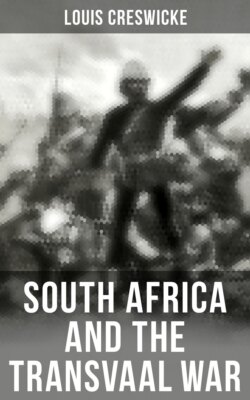Читать книгу South Africa and the Transvaal War - Louis Creswicke - Страница 67
На сайте Литреса книга снята с продажи.
THE BATTLE OF REITFONTEIN
ОглавлениеTable of Contents
On the morning of the 23rd, thirty men of the 18th Hussars rode into camp at Ladysmith, after having had some exciting adventures. The facts were these. On the arrival at Glencoe camp of the news of the Boer defeat at Elandslaagte, General Yule had detached a force to cut off the flying Boers. Unfortunately, the Hussars who were sent out for this purpose were themselves cut off, but at last, with the enemy at their heels, succeeded in fighting their way down a dangerous pass, and eventually effecting their escape. This, too, without the loss of a man!
To return to the great retreat. While General Yule was falling back to effect a junction with General White, the latter officer conceived a brilliant plan to ensure the safety of the returning force. He was aware that Yule's column was marching via the Helpmakaar road, Beith, and the Waschbank and Sunday River Valleys, and therefore, to cover the movement, he sent out a strong force to the west of the road. The force consisted of the 21st, 42nd, and 53rd Field Batteries, 1st Devons, 1st Liverpools, 1st Gloucesters, 2nd King's Royal Rifles (just arrived from Maritzburg), 19th Hussars, 5th Lancers, Natal Carabiniers, Border Mounted Rifles, and Imperial Light Horse.
The enemy was already strongly posted on the kopjes a mile and a half west of the railway and two miles south-east of Modder Spruit station, in all, some seven miles from Ladysmith. It was necessary, therefore, to keep him well occupied, and divert his attention from the Dundee column. On both sides firing soon commenced, but our guns were promptly silenced. Then the British took up a position three-quarters of a mile west of the railway, and for some twenty minutes kept up a heavy artillery fire supplemented by sharp volleys from the infantry. Before long the kopjes were cleared and the object of the British attack accomplished. The main body of the Boers retired in the direction of Besters, a point to the south of Ladysmith, where, in the circumstances, it was more advisable for them to be. In this battle a great deal of sharpshooting, especially at officers, took place on the part of the foe, who also resorted to their old tactics of discharging their guns and running away, again discharging them and again running—a trick they had been mightily fond of in their dealings with the Zulus, and which was calculated to tire out the fleetest antagonists. Colonel Wilford of the 1st Gloucester Regiment was mortally wounded. Sir George White had a narrow escape, as the Boers turned their artillery on the Staff, and their first shell came screaming within fifteen yards of the General. Captain Douglas, 42nd Battery, had also a marvellous escape, his horse having been wounded and his haversack ripped open by a splinter. In this smart engagement, as Sir George White in his official statement declared, "Our side confined its efforts to occupying the enemy and hitting him hard enough to prevent his taking action against General Yule's column." The manœuvre, as we know, was eminently successful, but was not executed without cost to those who assisted in it. The following was the official list of the officers killed and wounded:—
1st Battalion Gloucestershire Regiment.—Killed: Lieutenant-Colonel and Colonel Edmund Percival Wilford. 42nd Battery Field Artillery.—Wounded: Lieutenant S. W. Douglas, shell-graze of abdomen, slight. 53rd Battery Field Artillery.—Major Anthony J. Abdy, shell-graze of right knee, slight; Lieutenant Arthur Montague Perreau, bullet wound, right leg, severe; Lieutenant George Herbert Stobart (from 34th Battery), bullet wound, finger, slight. 19th Hussars.—2nd Lieutenant A. Holford, bullet wound, slight. 1st Battalion Gloucestershire Regiment.—Lieutenant Carlos Joseph Hickie, slightly.
The Boers, triumphant, entered Dundee about the same time as General Yule and his worn-out troops were being enthusiastically greeted in Ladysmith. They attacked the Dundee Town Guard, putting it to flight, and turned many civilians out of their houses. Later, they mounted two big guns at Intintanyone, some 4500 yards from the Ladysmith camp, and their energies pointed to further activities.
